Super User
ANDRITZ to supply two fiber preparation systems for insulation material to Naturheld, Germany
International technology group ANDRITZ has received orders from Naturheld GmbH to supply two fiber preparation systems for its new production line in Grafenwöhr, Germany. With this project, Naturheld is also entering the insulation material sector. Start-up is scheduled for the second half of 2022.
ANDRITZ’s scope of supply comprises two lines with a state-of-the-art pressurized refining system, each featuring a capacity of up to 10 t/h and including the following technological highlights:
- Plug Screw Feeder for optimum dewatering prior to refining and advanced wear protection for longer screw lifetime
- C-Feeder for constant feeding of wood chips to the HC refiner and stable operation over the entire capacity range
- 44-1CP refiner for production of high-quality fibers with lowest possible energy consumption
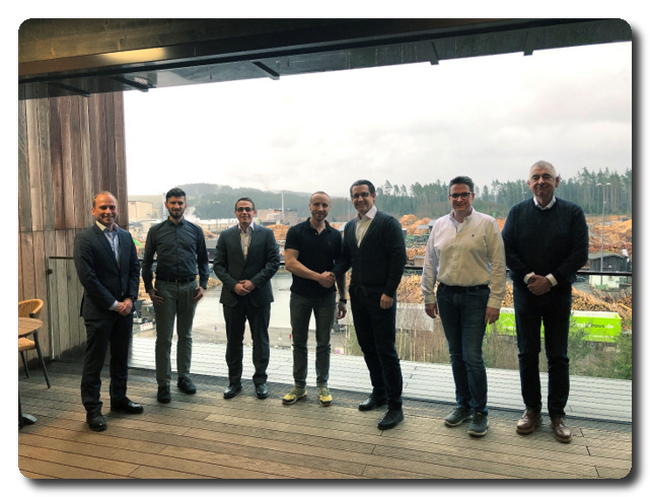 From left to right: Reinhard Schlager, Manager R&D, ANDRITZ; Andreas Sandner, General Manager, Naturheld; Christian Rosypal, Sales Engineer, ANDRITZ; Robert Friedl, General Manager, Naturheld; Michael Rupp, Vice President for Panelboard Systems, ANDRITZ; Sebastian Forster, Project Manager, Naturheld; and Stephan Lohmeyer, General Manager, Scantec “Photo: ANDRITZ”.
From left to right: Reinhard Schlager, Manager R&D, ANDRITZ; Andreas Sandner, General Manager, Naturheld; Christian Rosypal, Sales Engineer, ANDRITZ; Robert Friedl, General Manager, Naturheld; Michael Rupp, Vice President for Panelboard Systems, ANDRITZ; Sebastian Forster, Project Manager, Naturheld; and Stephan Lohmeyer, General Manager, Scantec “Photo: ANDRITZ”.
The systems will process a mixture of spruce and pine wood chips from Naturheld’s own wood processing plant, producing premium fiber material for flexible and hard insulation board as well as for blown-in insulation.
Robert Friedl, General Manager of Naturheld says: “The meetings with ANDRITZ headed in the right direction from the very beginning! The clear focus on ecological and economical production and the technical competences convinced us that we should enter the insulation material sector with ANDRITZ as our partner. Their experience in machine construction and customer-oriented approach to collaboration were both impressive and enjoyable!”
Michael Rupp, Vice President for Panelboard Systems in the ANDRITZ Paper, Fiber and Recycling Division, adds: “We are very impressed by Naturheld’s holistic approach, such as their regional wood supply or highly energy-saving and zero-wood-waste production process. We are looking forward to seeing ANDRITZ technology providing top performance in Naturheld’s new insulation material production facility.”
Naturheld is part of the Ziegler Group, an owner-managed company with more than 20 locations throughout Germany and almost 2,000 employees. The group has its origins in the wood industry and is also active in logistics, house construction, mechanical engineering, interior decoration, and the restaurant trade.
ANDRITZ GROUP
International technology group ANDRITZ offers a broad portfolio of innovative plants, equipment, systems and services for the pulp and paper industry, the hydropower sector, the metals processing and forming industry, pumps, solid/liquid separation in the municipal and industrial sectors, as well as animal feed and biomass pelleting. Plants for power generation, flue gas cleaning, recycling, and the production of nonwovens and panelboard complete the global product and service offering. Innovative products and services in the industrial digitalization sector are offered under the brand name Metris and help customers to make their plants more user-friendly, efficient and profitable. The publicly listed group has around 26,700 employees and more than 280 locations in over 40 countries.
Matrix goes back to Source to manufacture its innovative seating structure for wheelchair users
A Plymouth manufacturer is playing a key role in helping develop a new seating system for wheelchairs that improves function and corrects body posture.
Source Engineering, a specialist in pressed and machined components, has supported Matrix Seating with a complex stamped part that acts as a locking clamp for the unique micro modules that are shaped to deliver customised support.
A 5-strong engineering team has worked with inventor Dr Steve Cousins to come up with a 11-stage progression tool capable of producing the ‘lock’ in spring steel – vital for delivering strength and flexibility at a unit price that works.
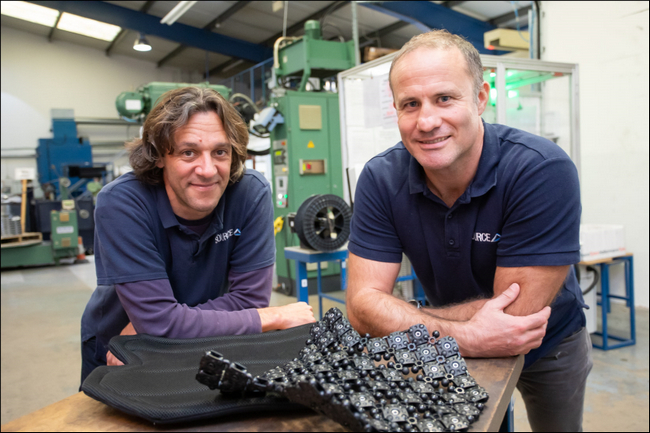 (l-r) Pablo Gutierrez, Andrea Taylor and Ian Matthews (all Source Engineering)
(l-r) Pablo Gutierrez, Andrea Taylor and Ian Matthews (all Source Engineering)
120,000 of the components have already been manufactured and delivered, with an increase in sales from the UK, Europe, the Middle East and the US set to result in a surge in volumes.
“This is a really exciting project to be involved in and we are delighted to be able to use our design and manufacturing expertise to help people enjoy a longer and better standard of life,” explained Pablo Gutierrez, Technical Director at Source Engineering.
“Steve approached us about coming up with a stamped metal part to replace what was previously a plastic and then hybrid component. He’d been to a number of other suppliers, but we were the only one prepared to invest the design time in trying to come up with a solution that worked.”
He continued: “There was a lot to consider. We had to deliver a critically strong part that still allowed the system, which looks like a robust mesh and is fitted in place of the usual wheelchair back, to move to deliver the potential orthotic spinal correction.
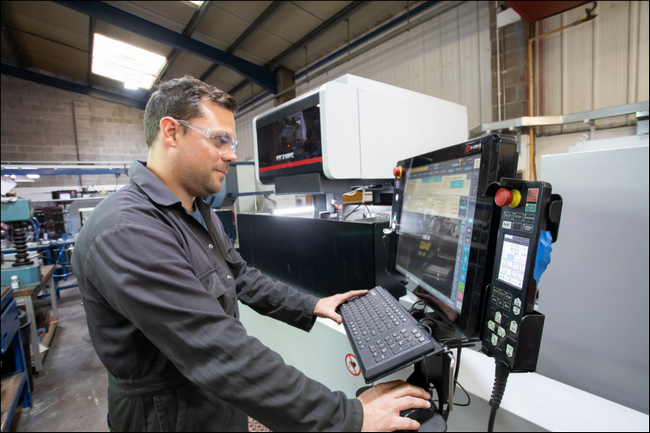
“Initially, it was deemed to be just one part for the locking clamp, but after a number of prototypes and iterations we found that it was best to manufacture two components - a top and a bottom that would be connected with a bolt. Tolerances were really tight and also had to meet clinical specification.”
Source Engineering has a long track record of taking projects from design and prototyping to volume production and this experience really came to the fore with this opportunity.
The 11-stage progression tool has been proven to deliver both parts successfully, with the firm’s wire erosion capabilities producing an accurate tooling insert that fits like a jigsaw to create the different circular and hex-shaped holes.
Repeatable quality has been outstanding and stringent lead times have been met on the initial orders allowing Matrix Seating to fulfil current orders.
Dr Steve Cousins, who spent 19 years at the Royal Hospital for Neuro-disability before founding the company, continued: “This is the fourth generation of locking clamp that holds our unique structure together and I believe we’ve found the long-term solution.
“Our manufacturing is all completed in the UK and Source Engineering is a very welcome addition to our supply chain, understanding the potential of our product and going above and beyond to deliver parts that have come through a tough engineering challenge.
“What was especially impressive was the ability to create parts that have a sharp edge in just the right place, so they dig into the nylon ball in the middle of the module. This was very technical and had to serve its main role, as well as not being exposed to the user of the chair.”
He concluded: “We feel that we finally have the right locking clamp and look forward to moving forward with Pablo and his team.”
Source Engineering, which is approaching 30 years in business in 2021, employs 32 people across its two divisions on the Langage Business Park.
Investment in a new high speed press line from Bruderer UK has given it additional capacity to secure reshoring contracts from abroad and support its desire to increase annual sales by 20% over the next twelve months.
For further information, please visit www.source-engineering.co.uk. More details on Matrix Seating, can be found at www.matrixseating.com
GPF RESEARCH: INVESTOR INTEREST IN METALS INCREASES ON INFLATION WORRIES
New research (1) by Global Palladium Fund (GPF) shows retail investors are increasingly concerned by the potential impact of rising global inflation on their savings and investments.
- One in four will increase metals investments or invest for the first time
Around 70% say they are concerned inflation will erode the value of their savings and investments while 16% are very concerned, the GPF, the issuer of metal-backed Exchange Traded Commodities (ETCs) found.
 Just 12% of investors questioned were not concerned about rising inflation, which is currently 5.4% in the US and 2.5% in the UK, and has already hit global stock markets amid concerns over potential Government and Central Bank action to curb it.
Just 12% of investors questioned were not concerned about rising inflation, which is currently 5.4% in the US and 2.5% in the UK, and has already hit global stock markets amid concerns over potential Government and Central Bank action to curb it.
The study shows retail investors are starting to recognise the potential for metals including gold as an investment to hedge against inflation.
More than a quarter (26%) say they will invest more, or for the first time, in metals – with 14% planning to increase their allocation to gold and other metals and 12% planning to invest for the first time. Around 73% say they have no plans to invest in metals while only 1% plan to reduce investments.
Alexander Stoyanov, Chief Executive Officer of GPF said: “Concern about rising inflation has already spooked stock markets worldwide and the impact of inflation on cash savings means real returns are negative. The worries about inflation are feeding through to retail investors, and that is increasing interest in strategies to counter inflation and potential Government and Central Bank action. All of this highlights the role of metals, and gold in particular, as a traditional hedge against the inflation. But it is also worth remembering that the case for investing in metals is much broader than simply as an inflation hedge.”
-Ends-
Notes to editors:
- Global Palladium Fund commissioned the independent research agency Consumer Intelligence to interview 1,048 retail investors holding stock market investments using an online methodology between July 16th and 17th 2021
Capital at risk
Global Palladium Fund
The Global Palladium Fund, set up by Nornickel in 2016, strives to advance the development of world-changing technologies in essential areas such as aerospace, electronics, and the automotive industries to help make the world a better place. In an industry first, GPF is enabling industrial consumers and investors access to a range of metals in a variety of formats, including the ETCs. GPF is proud to be supported by Nornickel. Its products are in high demand across the globe, and it has operations in the Russian Far North, Finland, and South Africa.
Sustainably sourced
Good Delivery Rules’ set by LBMA, LPPM, and LME for precious and base metals are universally acknowledged as the de facto international standard for due to the strict criteria that apply to responsible mining operations and protection of human rights.
LBMA established the Responsible Gold Guidance for Good Delivery Refiners that follows the five-step framework due diligence of the OECD Due Diligence Guidance for Responsible Supply Chains of Minerals.
For more information, visit: www.gpf.global
Nornickel
Nornickel is the world’s largest producer of palladium, high-grade nickel and a major producer of platinum, copper, precious metals, and rare earths.
Evaluating Time Sync Variation by Measuring PTP Wander with MT1000A
Improved Time Synchronization Measurement for 5G Mobile Network I&M
Anritsu Corporation has added a function for PTP wander, a metrics for evaluating frequency variations as low as 10 Hz to the PTP*1 network time synchronization error to the company's smallest-in-class 100 Gbps Network Master Pro MT1000A.
5G networks require high real-time communications supporting anticipated new services in various industries, such as autonomous vehicles, smart factories, telemedicine, etc. PTP wander is a key index expressing long-term time synchronization stability. Adding this improved time sync measurement to the MT1000A will play an important role in assuring 5G network quality.
Development Background
Due to their advantages of ultra-high speeds, high reliability and low latency, and multiple simultaneous connections, 5G communications networks are spreading into various use scenarios
Of these, high-reliability and low-latency communications are key features for implementing various industrial use cases, such as autonomous vehicles, smart factories, telemedicine, etc. Applications using these mission-critical technologies demand the smallest possible communications latency to facilitate equipment peer-to-peer communications at the highest speeds in almost real time, while also requiring precision time synchronization between each equipment.
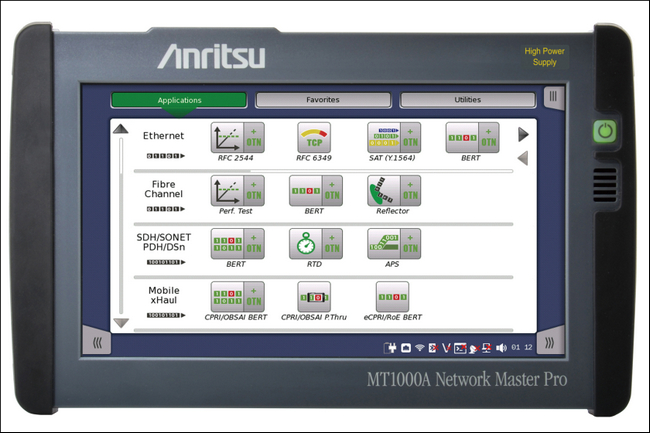
Additionally, implementing low-latency communications requires support for MEC*2 architectures in 5G networks, and precision time synchronization is essential to achieving communications between MEC systems distributed at each site.
Implementing time synchronization uses network technologies called SyncE*3 and PTP and assuring high accuracy and high stability synchronization using these technologies is linked to operators’ service quality guarantees about high speeds and low latency.
Anritsu has been building instruments with built-in jitter and wander test functions to measure instabilities in networks ranging from the SDH/SONET era to modern transport networks, contributing to development of core and metro networks. Based on this long experience and high-level technologies, the company has now added this new time error PTP wander measurement function to MT1000A time synchronization measurements. Measuring wander supports quantitative evaluation of long-term synchronization stability. In addition, support for measurement of new time-synchronization networks called PTS*4 will help assure customers’ service quality guarantees.
Product Outline
The MU100090B is a GNSS*5 disciplined oscillator supporting the GPS, QZSS, Galileo, Beidou, and GLONASS. It can receive signals from each artificial satellite system and outputs UTC-traceable reference time and 10-MHz frequency signals. This reference timing is supplied to the portable MT1000A supporting SyncE and PTP up to 25 Gbps to measure network time synchronization accuracy.
Moreover, combination with the SyncE Wander MU100011A-021 and MU100090B software options facilitates ITU-T recommended pass/fail evaluation of network-supplied Ethernet frequency accuracy.
When used with the Site Over Remote Access MX109020A software, multiple MT1000A units located at separate sites can be remotely operated and monitored from a central office to support speedy troubleshooting when synchronization problems occur.
Technical Terms
*1 PTP
Abbreviation for Precision Time Protocol; IEEE1588v2 protocol for matching time between devices to achieve nanosecond-level time synchronization accuracy.
*2 MEC
Abbreviation for Multi-access Edge Computing; technology for implementing ultra-low-latency internet access by deploying cloud servers near to consumers.
*3 SyncE
Abbreviation for Synchronous Ethernet standard; unlike asynchronous Ethernet, uses ITU-T standardized frequency synchronization to improve communications quality.
*4 PTS
Abbreviation for Partial Timing Support; one form of time-synchronization architecture using PTP assuming some network equipment does not support PTP. Profile standardized by ITU-T G.8275.2.
*5 GNSS
Abbreviation for Global Navigation Satellite System; positioning system using artificial satellites. GPS is one type of GNSS operated by US, along with EU's Galileo, Russia's GLONASS, China's Beidou, and Japan's QZSS.
About Anritsu
Anritsu Corporation (www.anritsu.com), a global provider of innovative communications test and measurement solutions for 125 years. Anritsu’s philosophy engages customers as true partners to help develop wireless, optical, microwave/RF, and digital solutions for R&D, manufacturing, installation, and maintenance applications, as well as multidimensional service assurance solutions for network monitoring and optimization. Anritsu also provides precision microwave/RF components, optical devices, and high-speed electrical devices for communication products and systems. The company develops advanced solutions for 5G, M2M, IoT, as well as other emerging and legacy wireline and wireless communication markets. With offices throughout the world, Anritsu has approximately 4,000 employees in over 90 countries.
To learn more visit www.anritsu.com
Modern modular mine built from bigger blocks
The State of Western Australia is one of the world’s key producers of iron ore – a critical raw material in steelmaking. But such resources are in remote locations, even by Australia’s vast standards. BHP’s US$3.6 billion South Flank project, located in the Pilbara region, uses digital connectivity and autonomous-ready fleets, and is one of the most advanced of its kind in Australia.
To build this facility, over 1,000 components needed to be transported to site safely, on schedule and in the right sequence. These items - with a cumulative weight in excess of 29,500t - needed to be transported 340km across the state’s barren interior. This had to be done within a demanding timeframe to keep the construction schedule on track.
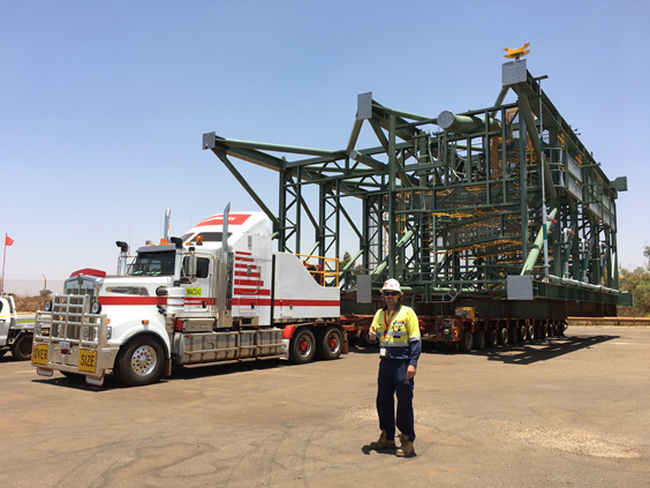
The cargo would be taken from the ship’s hook at Port Hedland and across a route largely consisting of public highways. Transporting these modules in the largest possible pieces would reduce the time spent integrating them on site - but the maximum transport size is always limited by the width and condition of the route.
The possibilities for what could be transported on this stretch of tarmac were pushed to new limits as Mammoet delivered a 349t module comprising the train load out bin gate and HPU module. This was the heaviest load ever carried along this stretch of Western Australia’s Great Northern Highway.
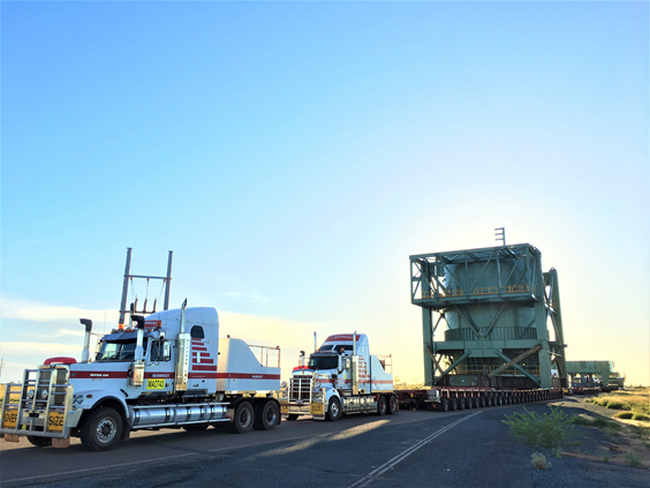
Early planning creates new possibilities
Restrictions were also placed on when modules could be transported, which varied depending on their size: those wider than 8.5m needed to travel at night, so that the transport had the lowest economic impact on the surrounding community, and public road users. A rolling roadblock was set up to shut down the highway in sections, minimizing the transport’s impact further still.
To achieve this required skilled logistics planning and early engagement with the project’s Construction Contractors - to identify precisely what could be transported and how.
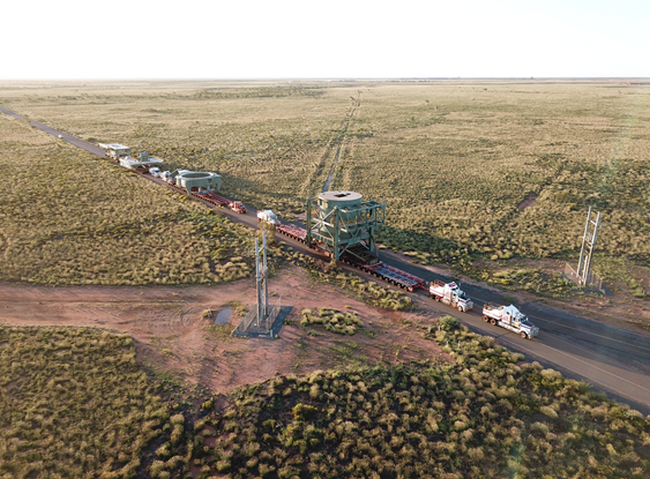
Pete O’Connell, Senior Project Manager at Mammoet explains:
“Engagement at the planning stage with EPCs can help to optimize how our package of work integrates with other workflows. It was particularly critical in this case - given the size and volume of components that needed to be on site in a specific order and timeframe for construction to proceed smoothly.
We were able to advise the modularization engineers on how to get maximum benefit from the load sizes possible on the route, in terms of their overall dimensions and the maximum weights to cross structures such as bridges. We were then able to plan from the very start the equipment and expertise we would need to best carry out the work.”
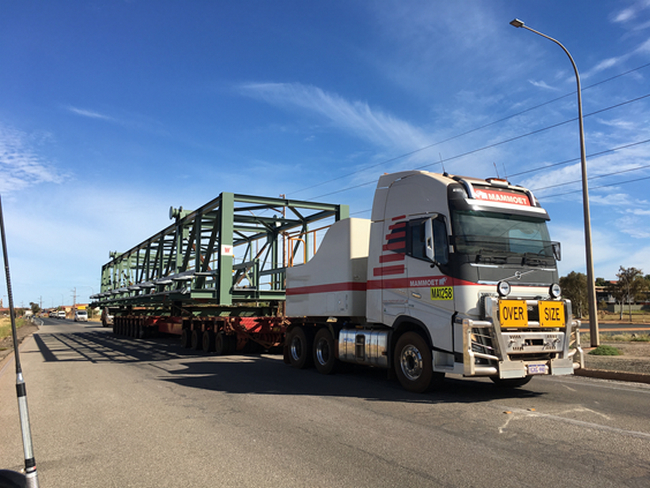
Mammoet utilized a specially-built trailer type to minimize the weight of the transport equipment itself and therefore increase the size of module that could be carried. Overall weight limitations on Australian highways meant a lighter alternative to the traditionally utilized 4-file platform trailer was needed to avoid reducing the size of the modules themselves.
Smaller module sizes, of course, mean more transportations - and in turn additional transport and integration costs. Mammoet’s extensive equipment inventory was put to good use in devising a 3-file trailer solution. This allowed the desired size of module to be transported within local regulations.
Tightening timeframe
Delivery of such a large scale of transport work was already a significant challenge within the planned 15-month timescale, but due to delays earlier in the project schedule this cargo needed to be transported in a shorter timeframe.
This meant that resources needed to double – and fast. A tough task in this desolate and sparsely-populated part of the world, but with its global reach and standardized learning systems Mammoet was able to source and train more operatives from within Australia to quickly step up the pace.
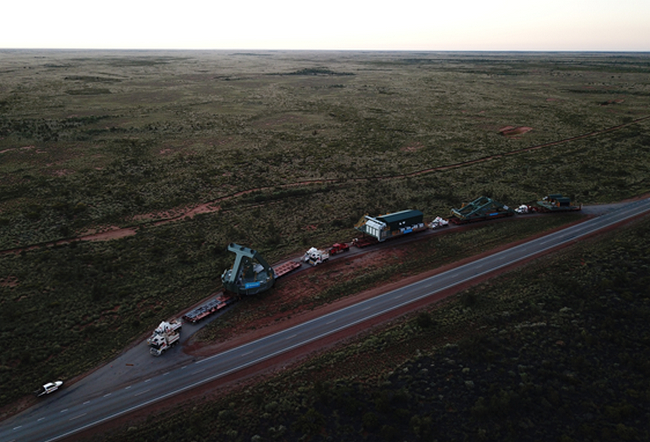
Despite ongoing travel restrictions due to coronavirus, Mammoet was able to mobilize a team of over 90 people – half of whom came from outside the state or abroad. Before long, crews were working across day and night shifts at Port Hedland, keeping things on schedule.
Another important part of this solution was to increase the number of trailers being used, avoiding the need for them to be reconfigured between journeys, hence achieving a faster turnaround. With the industry’s biggest equipment fleet, Mammoet was able to redeploy trailers from across Australia and the wider region. O’Connell continues:
“Flexibility is always key in large projects such as this, as changes in project schedules are to be expected. As the largest supplier in our industry, the talent pool, training capabilities and equipment inventory that we have access to prove invaluable in making sure we can react quickly and adapt to client requirements - avoiding delays even if there is a change to the plan.”
A productive new asset
A key development in driving economic growth for the Pilbara region and the State of Western Australia, BHP’s $3.6 billion South Flank mine has created more than 2,500 construction jobs and 600 ongoing operational roles. It is set to provide a profitable asset for BHP and secure employment for the Pilbara population for decades to come.
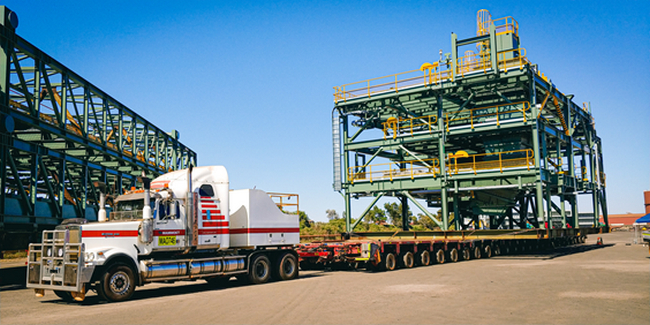
Wouter Mink, Managing Director of Mammoet Australia:
“We are delighted that South Flank delivered first ore during May 2021. This project helps to continue our commitment to the Pilbara region. The transport package was always going to play a key role in achieving this, and we were extremely pleased to have delivered this successfully despite the challenges we faced - including a global pandemic impacting on how, when and where we could source our team.”
Construction of this 21st century facility using modern modularized techniques was aided significantly by Mammoet’s expertise in getting over 1,000 oversized items to site safely and on time; and also by providing critical guidance to optimize the size of cargo and ensure the most efficient project. It is a sentiment echoed by Heath Tyler, BHP South Flank Area Project Manager:
“The South Flank project represents a major investment by BHP and a key element in our strategy for the region. With the transport package playing such a critical part in achieving a successful build, we needed a partner that had the proven expertise, equipment and boots on the ground to deliver. Mammoet has proven a great fit for these criteria.”
Mammoet
Mammoet helps clients with Smarter, Safer and Stronger solutions to any heavy lifting or transport challenge. We aim to develop long term relationships in order to understand their businesses and challenges best, so we can realize the most efficient and cost-effective approaches. We have a unique global network and an unparalleled fleet of equipment. Through deep and longstanding engineering expertise and the highest quality and safety standards in execution we bring an intelligent and flexible approach to projects across a wide breadth of industry sectors. Clients trust us to help them achieve feats that were once considered impossible, and we have often broken records in doing so.
For more information, visit www.mammoet.com
BHP merger adds complications for Woodside’s energy transition narrative
The merger of BHP’s petroleum business with Australian oil and gas producer, Woodside. The deal adds significant oil production for Woodside and will ultimately lead to a more carbon intensive product base over the near term, says GlobalData, a leading data and analytics company.
Daniel Rogers, Senior Oil and Gas Analyst at GlobalData, comments: “The deal signifies a tale of two stories; on the one hand BHP offloading this side of the business will be seen as a positive from an ESG standpoint, reducing its exposure to an emissions intensive business segment. However, Woodside taking on largely oil weighted producing assets will increase the carbon emissions intensity of the products it sells.”
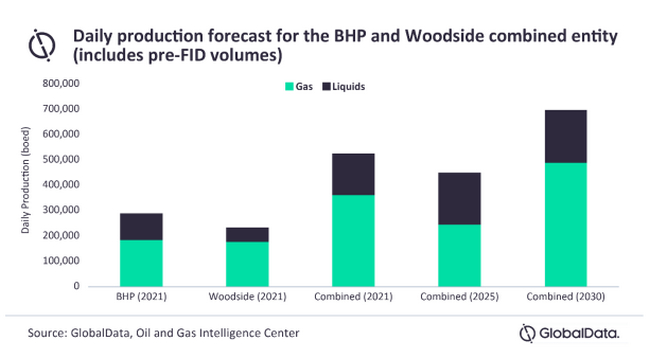
Rogers continues: “Crude oil only accounts for around 15% of Woodside’s current production mix. However, by incorporating BHP’s portfolio, Woodside would triple its crude oil production. Additionally, with Sangomar, its Senegalese oil development due online by 2024 plus BHP’s Mad Dog Phase 2 and Shenzi North oil projects, the combined entity’s production in 2025 would be closer to a 50% oil weightage.
“Questions are then posed as to how this deal benefits Woodside from an ESG perspective and how increasing its share of oil over gas aligns with a lower carbon narrative. While Woodside will benefit from a more diversified portfolio, ultimately its carbon goals will be further challenged through increased Scope 3 emissions and a more carbon intensive product base.
“Gas is, however, expected to be more prominent in the longer-term picture for the merged entity, but will depend on FIDs being taken on its major gas projects Scarborough and Pluto Train II. It therefore becomes crucial for the merged entity to sell down its stake to bear the entire US$12bn cost of the integrated project.”
- Quotes provided by <Analyst name>, <analyst title> at GlobalData
- <Include any information you think the journalist might need to know. This can be a good place to highlight a related report or move some ‘known news’ to>
About GlobalData
4,000 of the world’s largest companies, including over 70% of FTSE 100 and 60% of Fortune 100 companies, make more timely and better business decisions thanks to GlobalData’s unique data, expert analysis and innovative solutions, all in one platform. GlobalData’s mission is to help our clients decode the future to be more successful and innovative across a range of industries, including the healthcare, consumer, retail, financial, technology and professional services sectors.
Decorative marbling for injection-molded parts made of Ultrason®
With a patent pending BASF technology it is now possible to produce marbled serial components made of Ultrason® using a standard injection molding process. The coloring technique opens up virtually unlimited possibilities for designers to use BASF's polyarylethersulfone to color household appliances, catering bowls and containers as well as visible components. For the first time, surface effects such as color shades, color streaks and patterns can be reproduced: Injection-molded parts of one series look alike but are not completely identical. The technique has proven to be successful with the two injection-molding grades Ultrason® E (PESU: polyethersulfone) and Ultrason® P (PPSU: polyphenylsulfone) for the production of one-of-a-kind parts, which at the same time benefit from the outstanding properties of Ultrason® in terms of mechanical, thermal and chemical resistance as well as approval for food contact.
- Now possible for the first time: reproducible marbling patterns for unique serial production
- BASF’s polyarylethersulfone offers unlimited color possibilities for household appliances, catering bowls and containers as well as visible parts
- Marbled bowls showcased at Fakuma 2021, Friedrichshafen, Germany
The new process, which was developed at BASF's pilot plant for injection molding and extrusion in Ludwigshafen, makes it possible to produce marbled molded parts on conventional injection molding machines more easily and with a greater degree of process reliability than before, using new types of nozzle inserts and a special dosing technique. With its lightly honey-colored tint, Ultrason® granules are suitable for light shades and tints as well as abstract patterns by solid coloring that look like natural materials such as wood or marble. "Marble effects have always been an eye-catcher in the plastics world," says Georg Graessel from global Ultrason® business development at BASF. "Until now, these effects were only possible with complex two-component injection molding and did not guarantee reproducibility. With marbling, we are adding another way of coloring to the already versatile design possibilities of Ultrason®. With appropriate temperature control of the injection molding machine, attractive, high-contrast patterns are possible for our P and E injection molding grades. So far, our customers have been able to mold transparent, translucent, and, of course, solid-colored components from Ultrason®."
Marbled components made of Ultrason® can be used in a variety of ways: in household articles such as bowls, cups, plates, and catering utensils, also for microwave usage. Additionally, marbling effects can be applied to eyeglass frames, handles as well as visible components of electrical and electronic appliances, decorative panels and covers. These applications benefit from the excellent properties of BASF’s polyarylethersulfone: steam resistance up to 180°C, excellent strength and toughness over a wide temperature range, very good resistance to industrial cleaning agents, and repeated sterilization. Ultrason® also has the relevant food approvals for the EU and the USA.
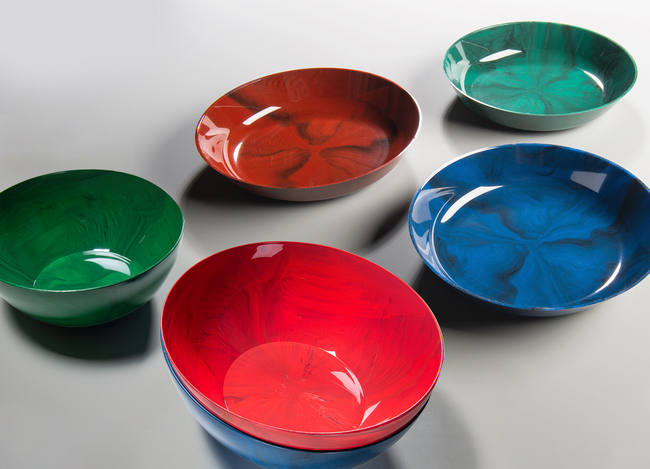 Marbled serial components made of Ultrason® using a standard injection molding process: The news coloring technique enables designers to use BASF's polyarylethersulfone to color household appliances, catering bowls and containers as well as visible components with marbling effects. Photo: BASF 2021
Marbled serial components made of Ultrason® using a standard injection molding process: The news coloring technique enables designers to use BASF's polyarylethersulfone to color household appliances, catering bowls and containers as well as visible components with marbling effects. Photo: BASF 2021
Marbling according to the BASF process is possible on conventional injection molding machines equipped with only one plasticizing unit and an open nozzle. The pre-colored base material and the high-contrast color masterbatch must be fed synchronously to the injection-molding cycle. The patterns in the molded part are then achieved by separating and merging the melt streams. This is done with nozzle inserts, which are manufactured by 3D printing. These inserts offer great design freedom: not only mirror-image patterns can be created but also rotationally symmetrical patterns. This has not been possible with conventional processes to date. Other factors influencing the pattern design are the nozzle design itself, the mold's gating system, the location of the gate, and the flow behavior of the melt during mold filling. In addition to PESU and PPSU, the new BASF technique is also suitable for Ultrason® S and other thermoplastics.
Ultrason® is the trade name for BASF’s product range of polyethersulfone (Ultrason® E), polysulfone (Ultrason® S) and polyphenylsulfone (Ultrason® P). The high-performance material is used to manufacture lightweight components in the electronics, automotive and aerospace industries as well as in water filtration membranes and in parts that come into contact with hot water and food. Because of their extraordinary property profile the Ultrason® grades can substitute thermosets, metals and ceramics in many applications.
For more information: www.ultrason.basf.com
About BASF’s Performance Materials division
BASF’s Performance Materials division encompasses the entire materials’ know-how of BASF regarding innovative, customized plastics under one roof. Globally active in four major industry sectors – transportation, construction, industrial applications and consumer goods – the division has a strong portfolio of products and services combined with deep understanding of application-oriented system solutions. Key drivers of profitability and growth are our close collaboration with customers and a clear focus on solutions. Strong capabilities in R&D provide the basis to develop innovative products and applications. In 2020, the Performance Materials division achieved global sales of €5.63 billion. More information online: www.plastics.basf.com.
About BASF
At BASF, we create chemistry for a sustainable future. We combine economic success with environmental protection and social responsibility. More than 110,000 employees in the BASF Group contribute to the success of our customers in nearly all sectors and almost every country in the world. Our portfolio is organized into six segments: Chemicals, Materials, Industrial Solutions, Surface Technologies, Nutrition & Care and Agricultural Solutions. BASF generated sales of €59 billion in 2020. BASF shares are traded on the stock exchange in Frankfurt (BAS) and as American Depositary Receipts (BASFY) in the U.S. Further information at www.basf.com.
The Next Generation of Vibration Testing
Test and measurement expert HBK has launched a new LDS shaker system that provides efficiency far beyond just saving time - the LDS V8750 shaker + XPAK shaker system.
With today's increasingly complex and advanced vibration testing, such as environmental stress screening with a slip table and climatic chamber, manufacturers and engineers need a lot from their vibration testing solutions.
Lack of energy saving and power balancing features, recalibration of armature position, vibration profile limitations as well as growing their own testing capabilities are just a few of the challenges, limiting the testing efficiency.
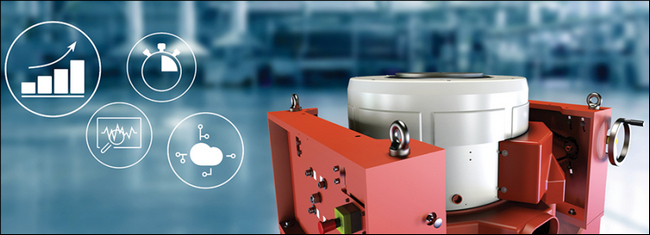
HBK’s LDS V8750 shaker + XPAK shaker system has been specifically designed to meet the demanding specifications for shock testing in standard configurations. The medium-force, air-cooled shaker system reduces overall costs while ensuring a reliable and futureproof system. The Inductive Centring System enables accurate guiding of the built-in armature with minimal maintenance and uninterrupted operation.
Uninterrupted operation is also guaranteed through the new remote services to aid predictive maintenance and fault detection. This can be achieved by the user or with assistance from HBK’s service team. Additionally, the COOL and QUIET modes of the XPAK amplifier enable the user to reduce the acoustic noise and energy consumption, while simultaneously lowering the cost of ownership and reducing carbon footprint.
More information about HBK’s V8750 is available on the company’s website: https://bksv.com/instruments/vibration-testing-equipment/lds-shakers/medium-force-shakers/lds-v8750
About HBK – Hottinger Brüel & Kjær
The two market leaders, HBM and Brüel & Kjær, have joined forces as HBK – Hottinger Brüel & Kjær – to form the world’s foremost provider of integrated test, measurement, control, and simulation solutions.
HBK – Hottinger Brüel & Kjær – provides a complete portfolio of solutions across the test and measurement product life cycle, that unite the physical world of sensors, testing and measurement with the digital world of simulation, modelling software and analysis. By creating a scalable and open data acquisition hardware, software and simulation ecosystem, product developers can cut time-to-market, drive innovation and take the lead in a highly competitive global marketplace.
For more information, please visit www.hbkworld.com
ARMOLOY TDC® COATED LINEAR RAIL AND BALLSCREWS FROM MATARA FOR HIGH WEAR RESISTANCE
When motion equipment is being used in harsh environments, it needs to be of resilient design and manufactured from highly durable materials. Matara UK Ltd, specialist in automation, pneumatics and linear motion products, provides customers with Armoloy TDC® coated linear rail and ballscrews for maximum longevity in demanding applications and locations.
Matara linear rail and ballscrews use top grade materials and are subjected to extremely rigorous heat treatment and grinding processes, for high quality products. For added protection, and where the standard materials will not suffice, these products are now available with Armoloy TDC® coating, which is a hard (78Rc), thin, dense chromium coating with a micro-nodular surface texture. Using Armoloy® TDC coatings provides corrosion protection equal to 440 series stainless steel.
The nodular finish of the coating reduces the amount of the rail and ballscrews’ surface area exposed to surfaces in contact with it, thereby substantially reducing friction for smoother movement over rolling surfaces, as well as extending wear life by nearly 50% when compared with a typical hard chrome coating. The nodular finish also retains smaller amounts of industrial lubricants for longer periods, both further reducing friction and creating a cleaner work environment.
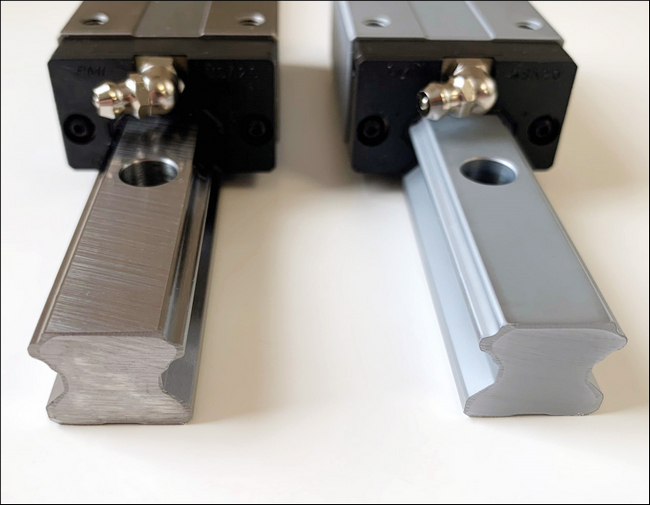 Matara linear rail without and with Armoloy TDC coating
Matara linear rail without and with Armoloy TDC coating
With the Armoloy TDC® coating, Matara linear rail and ballscrews have improved resistance to chemicals, detergents and weld spatter. They have anti-galling, spalling and fretting properties and are capable of withstanding very wide temperature ranges.
Application of this innovative coating is through a proprietary means at a precise 2.5 – 5 micron even deposit which will not affect the linear rail and ballscrews’ geometry, weight or balance and will not alter the metallurgical structure. 100% coverage is achieved with absolute adhesion, i.e. the coating will not chip, flake or peel, and a satin silver appearance free of rack marks is guaranteed.
Matara linear rail and ballscrews with Armoloy TDC® coating can be used in most industries, but are especially well suited to customers operating in corrosive environments, such as battery plants and marine applications, and for those who undertake regular wash down such as pharmaceutical manufacturing and food processing plants. The coating is USDA approved and FDA compliant, as well as compliant with EC 1935/2004 for food contact.
Matara has over 23 years’ experience in the linear motion industry. It has a large UK stock of linear motion control automation components, including precision ground and rolled ball screws, power lead screws and linear guides and rails, as well as providing cost-effective, bespoke linear motion control solutions. Matara is part of Rubix, Europe’s largest supplier of industrial maintenance, repair and overhaul products and services. For more information, please go to www.matara.com/
About Matara
Matara, established in 1995, is a specialist supplier of bespoke linear motion, automation, and pneumatic components. Based in Tewkesbury, Gloucestershire, Matara are a team of 27 employees, serving a wide range of industries, including printing & packaging, food & drink, pharmaceutical and metal processing. In the year ended 31 March 2020, Matara reported sales in excess of £5m.
About Rubix
Rubix is Europe’s largest supplier of industrial maintenance, repair and overhaul products and services. It was created from the merger of IPH with Brammer in 2017, following the acquisition of Brammer by Advent International.
From around 750 + locations across 22 countries, 8,000 employees help to identify, install and provide a leading range of industrial products and services to more than 200,000 customers. The business had combined sales of €2.4bn in 2020 and is a leading distributor in bearings, transmission and automation, fluid power, machining, assembly, tools and protective equipment.
ECO-SPECIALISTS URGE GOLF CLUBS TO FOLLOW 10-POINT GUIDE TO A GREENER FUTURE
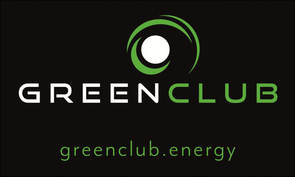 Working with the golf and leisure sector to help venues realise their sustainable goals, GreenClub has already made a huge impression in changing attitudes and approaches to the environment since launching last autumn.
Working with the golf and leisure sector to help venues realise their sustainable goals, GreenClub has already made a huge impression in changing attitudes and approaches to the environment since launching last autumn.
London Golf Club, host of the Cazoo Classic on the European Tour this summer, and Roganstown Hotel & Country Club in Ireland are just two of the venues to have benefitted from working with the specialist environmental consultants to further their combined aim of carbon neutrality.
But GreenClub believes that the golf and leisure sector can do much more to help protect and promote the environment and, as the global golf industry gears up for COP26 in Glasgow next month – the 26th edition of the United Nations Climate Change Conference – the company has unveiled a 10-point plan that it is urging golf clubs and venues to adopt so that they can start their journey towards ultimately becoming ‘net zero.’
GreenClub’s eco-checklist covers all parts of everyday life and features a number of simple measures that not only promote a greener future but can also benefit venues financially.
- Switch off the lights and switch your bulbs to LED.
- Switch off “standby” appliances. When replacing old appliances, look for more energy efficient ones.
- Check that the fridge and freezer thermostats are at their most efficient setting and defrost regularly to maintain efficiency.
- Turn down the heating – even just one degree will make a difference.
- Be smart on water usage. Fit regulators on taps, showers and toilets so water can’t be left running.
- Check your building insulation and reduce draughts by closing doors and curtains.
- Use a smart meter to monitor energy usage.
- Encourage and incentivise your customers to car share ….. or cycle to your venue.
- Source the produce you require for your venue locally.
- Cut down on single-use plastics and use wooden or recycled golf tees.
GreenClub chief executive, Liam Greasley, said: “This is a very real issue – it’s not a box ticking exercise – and the golf and leisure industry needs to start taking note of these issues.
“The list that we have compiled and are asking people to follow shouldn’t be seen as a replacement for engaging in a longer-term strategy to make a difference. This is very much the start of the path towards carbon neutrality, and we would urge any venue that is serious about making a long-term commitment to the environment to speak to us.”
GreenClub – a principal partner of the PGA – is committed to improving sustainability in the golf industry and beyond and their objective continues to gather pace on several fronts. As well as their consultation services to assess current and future needs of any business as they seek to reduce their carbon emissions, venues can also become generators of their own green renewable energy by utilising renewable energy options. In some cases, any surplus energy can then be sold to the local market, rather than back to the grid.
For further information, visit www.greenclub.energy
ABOUT GREENCLUB:
GreenClub’s approach is consultative and collaborative to enable golf and leisure facilities to provide services in each of the following key areas
Sustainability
Conducting a comprehensive audit of the facility to understand the current usage and operations, as well as a review of infrastructure services, waste, water and paper use.
Future Proof
Assessment of the future needs of the business to deliver new services like electric vehicles and charge points. Most new technology is electric-powered or managed, which also needs to be factored in.
Generation
Venues can become generators of their own green renewable energy with solar installations, rather than relying solely on the grid. In some cases, any surplus energy can then be sold to the local market, rather than back to the grid.
Wind and solar installations can be expensive, but we offer a range of funding options to meet every facility’s needs: fully-funded schemes, financed and purchased solutions.
Accreditation
Recognition and credibility are vital components to reflect progress and the commitment to environmental responsibility within the industry. Accreditation will be awarded to venues on achieving those milestones.
